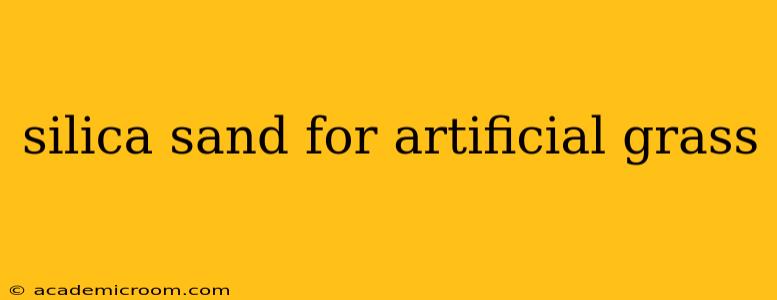Choosing the right infill for your artificial turf is crucial for its performance, longevity, and overall aesthetic appeal. While many options exist, silica sand stands out as a popular and effective choice. This comprehensive guide will explore the benefits, considerations, and best practices associated with using silica sand for artificial grass. We'll delve into everything you need to know to make an informed decision for your landscaping project.
What is Silica Sand?
Silica sand, primarily composed of silicon dioxide (SiO2), is a naturally occurring granular material known for its fine texture and excellent drainage properties. Its inert nature means it doesn't react with other materials, making it a safe and stable infill for artificial grass. Unlike some other infill options, silica sand is relatively inexpensive and readily available, contributing to its widespread use. The particle size and grading of silica sand can vary, impacting its performance within the artificial turf system.
Why Choose Silica Sand for Artificial Grass?
Several compelling reasons make silica sand a popular choice for artificial grass infill:
- Excellent Drainage: Silica sand facilitates excellent water drainage, preventing waterlogging and the growth of mold or mildew. This is crucial for maintaining a clean and healthy-looking lawn.
- Cost-Effective: Compared to other infill materials like rubber crumb or polyethylene, silica sand is generally more affordable. This makes it a budget-friendly option for larger projects.
- Improved Stability: Silica sand helps to weigh down the artificial turf blades, keeping them upright and preventing excessive movement. This improves the overall look and feel of the artificial grass.
- Inert & Safe: Silica sand is non-toxic and environmentally friendly, making it a safe option for children and pets. Its inert nature prevents chemical reactions or leaching into the soil.
- Enhanced Aesthetics: When used correctly, silica sand contributes to a more natural-looking lawn. The fine particles fill the gaps between the artificial turf fibers, creating a consistent and even surface.
What are the Different Types of Silica Sand?
Not all silica sand is created equal. The grain size and grading significantly impact its suitability for artificial grass infill. Generally, finer grades are preferred as they provide better compaction and a more consistent surface. It's crucial to specify the desired grading when purchasing silica sand for this application. Consult with a supplier to determine the appropriate grade for your specific needs.
How Much Silica Sand Do I Need?
The amount of silica sand required depends on several factors, including the area of your artificial lawn, the depth of infill desired, and the type of artificial grass being used. Always follow the manufacturer's recommendations for your specific artificial turf product. Underfilling can lead to an uneven surface, while overfilling can increase costs and potentially create drainage problems. Accurate calculation is key to a successful installation.
What is the Best Depth for Silica Sand Infill?
The recommended depth of silica sand infill usually ranges from ½ inch to 1 inch. However, this can vary depending on the specific artificial grass type and manufacturer’s recommendations. Using too little infill may result in an unstable surface, while excessive infill can lead to drainage issues and compaction problems. Always refer to the manufacturer's instructions.
Does Silica Sand Need to Be Washed?
While not always mandatory, washing silica sand before installation is often recommended. This process removes any dust, debris, or contaminants that could affect the look or performance of the artificial grass. Washing also helps ensure the sand is uniformly graded. Consult with your supplier regarding pre-washed options or the need for washing on-site.
Silica Sand vs. Other Artificial Grass Infill Materials:
Silica sand offers advantages and disadvantages when compared to other infill materials like rubber crumb or polyethylene. For example, rubber crumb can offer better shock absorption, but raises environmental concerns due to its composition. Polyethylene offers good performance but can be more expensive. The best choice depends on budget, environmental considerations, and performance expectations.
Maintaining Artificial Grass with Silica Sand Infill:
Regular maintenance is essential to prolong the life of your artificial grass and keep it looking its best. This typically involves brushing the surface to remove debris and occasionally topping up the silica sand infill to maintain the desired depth and evenness. Avoid using harsh chemicals or power washing, which could damage the artificial grass or wash away the sand.
By carefully considering the factors discussed in this guide, you can ensure that your artificial grass installation with silica sand infill is successful and provides a beautiful, durable, and long-lasting lawn for years to come. Remember to consult with professionals for guidance and support throughout the process.
